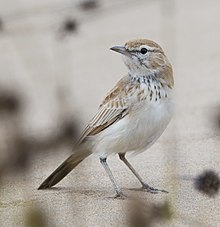| Dune lark | |
|---|---|

| |
| Near Walvis Bay | |
| Conservation status | |
 Least Concern (IUCN 3.1) | |
| Scientific classification | |
| Domain: | Eukaryota |
| Kingdom: | Animalia |
| Phylum: | Chordata |
| Class: | Aves |
| Order: | Passeriformes |
| Family: | Alaudidae |
| Genus: | Calendulauda |
| Species: | C. erythrochlamys |
| Binomial name | |
| Calendulauda erythrochlamys (Strickland, 1853) | |

| |
| resident range | |
| Synonyms | |
| |
The dune lark (Calendulauda erythrochlamys) is a species of lark in the family Alaudidae. It is endemic to Namibia where its natural habitat is subtropical or tropical dry lowland grassland.
The dune lark is the only avian creature that has evolved the ability to survive in the Namib Desert, which is one of the driest regions in the world.
Taxonomy
The dune lark was formally described in 1853 by the English naturalist Hugh Strickland based on specimens collected in Damaraland, a coastal belt near Walvis Bay in Namibia. He coined the binomial name Alauda erythrochlamys. The dune lark is now one of eight larks placed in the genus Calendulauda that was introduced by the English zoologist Edward Blyth in 1855. The name Calendulauda combines the names of two other lark genera: Calendula and Alauda. The specific epithet erythrochlamys combines Ancient Greek ερυθρος/eruthros meaning "red" with χλαμυς/khlamus, χλαμυδος/khlamudos meaning "cloak".
Four subspecies are recognised:
- C. e. erythrochlamys (Strickland, 1853) – Kuiseb River (Walvis Bay) to Koichab River (central west Namibia)
- C. e. barlowi (Roberts, 1937) – Koichab River to Aus (southwest Namibia)
- C. e. patae (Macdonald, 1953) – coastal southwest Namibia to northwest South Africa
- C. e. cavei (Macdonald, 1953) – inland southwest Namibia to northwest South Africa
Barlow's lark (Calendulauda barlowi) (including patae and cavei) was formerly considered to be a separate species. It is now lumped with the dune lark based on the very shallow genetic divergence and the essentially identical size and vocalizations.
References
- BirdLife International (2017). "Calendulauda erythrochlamys". IUCN Red List of Threatened Species. 2017: e.T22730531A112871583. doi:10.2305/IUCN.UK.2017-1.RLTS.T22730531A112871583.en. Retrieved 12 November 2021.
- Strickland, Hugh Edwin (1852). "List of a collection of birds procured by Mr. C. T. Andersson in the Damara country in south western Africa". In Jardine, William (ed.). Contributions to Ornithology for 1852. Edinburgh: W.H. Lizars (published 1853). pp. 141-160 .
- Mayr, Ernst; Greenway, James C. Jr, eds. (1960). Check-List of Birds of the World. Vol. 9. Cambridge, Massachusetts: Museum of Comparative Zoology. p. 26.
- ^ Gill, Frank; Donsker, David; Rasmussen, Pamela, eds. (August 2024). "Nicators, Bearded Reedling, larks". IOC World Bird List Version 14.2. International Ornithologists' Union. Retrieved 10 September 2024.
- Jobling, James A. "Calendulauda". The Key to Scientific Names. Cornell Lab of Ornithology. Retrieved 10 September 2024.
- Jobling, James A. "erythrochlamys". The Key to Scientific Names. Cornell Lab of Ornithology. Retrieved 10 September 2024.
- Alström, P.; Mohammadi, Z.; Enbody, E.D.; Irestedt, M.; Engelbrecht, D.; Crochet, P.-A.; Guillaumet, A.; Rancilhac, L.; Tieleman, B.I.; Olsson, U.; Donald, P.F.; Stervander, M. (2023). "Systematics of the avian family Alaudidae using multilocus and genomic data". Avian Research. 14: 100095. doi:10.1016/j.avrs.2023.100095.
- Ryan, P.; Kiwan, G.M. (2022). Billerman, S.M. (ed.). "Dune Lark (Calendulauda erythrochlamys), version 1.0". Birds of the World. Ithaca, NY, USA: Cornell Lab of Ornithology. Retrieved 10 September 2024.
External links
- Species text - The Atlas of Southern African Birds
| Taxon identifiers | |
|---|---|
| Calendulauda erythrochlamys |
|
| Calendulauda barlowi | |
This Alaudidae-related article is a stub. You can help Misplaced Pages by expanding it. |